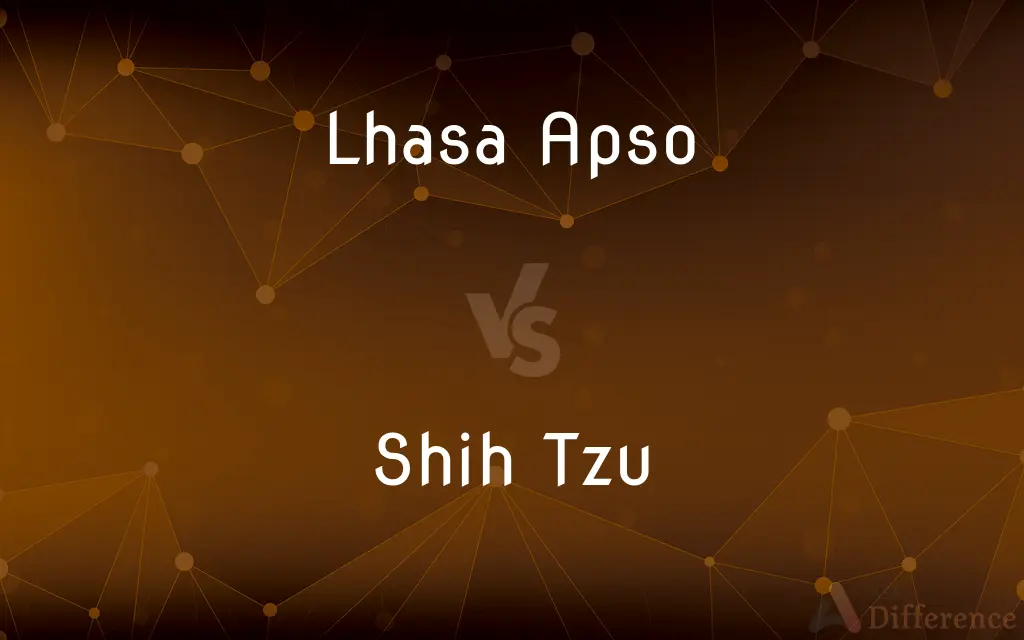Lhasa Apso vs. Shih Tzu — What's the Difference?
By Tayyaba Rehman — Published on January 24, 2024
Lhasa Apso, originating from Tibet, is larger with a longer snout, while the Shih Tzu, of Chinese origin, is smaller with a more distinct facial "chrysanthemum" pattern.

Difference Between Lhasa Apso and Shih Tzu
Table of Contents
ADVERTISEMENT
Key Differences
Lhasa Apso, a Tibetan breed, is known for its long, flowing coat and a more pronounced snout, differentiating it from the Shih Tzu, which boasts a shorter, flatter face. The Shih Tzu, often referred to as a "lion dog" in China, displays a uniquely round face and dense coat.
Regarding temperament, Lhasa Apsos are independent and can be wary of strangers, a contrast to the typically friendly and outgoing nature of Shih Tzus. While both breeds share a royal ancestry, the Shih Tzu's history as a lapdog for Chinese royalty has ingrained a more sociable demeanor compared to the more protective Lhasa Apso.
In terms of grooming, Lhasa Apsos require regular brushing due to their longer coats, while Shih Tzus, despite their luxurious mane, can be slightly easier to maintain. Both Lhasa Apso and Shih Tzu require regular grooming, but the Lhasa Apso may need more frequent attention to prevent matting.
The size of Lhasa Apso and Shih Tzu also presents a notable difference. Lhasa Apsos are generally larger and sturdier, with Shih Tzus being smaller and more compact, making the latter more suitable for apartment living.
In terms of health, Lhasa Apsos are prone to certain eye and kidney issues, while Shih Tzus commonly face respiratory and eye problems, mainly due to their brachycephalic facial structure. Both breeds, however, are known for their longevity and robust health when properly cared for.
ADVERTISEMENT
Comparison Chart
Origin
Tibet
China
Size
Larger, heavier
Smaller, lighter
Face Shape
Longer snout
Short, flat face
Coat
Longer, needs more grooming
Shorter, slightly easier to groom
Temperament
Independent, cautious with strangers
Friendly, outgoing
Compare with Definitions
Lhasa Apso
Appearance: Long, flowing hair and a keen, alert expression.
The Lhasa Apso’s expressive eyes peeked out from beneath its long hair.
Shih Tzu
Appearance: Characterized by a short snout and large, dark eyes.
The Shih Tzu’s cute face with its short snout always draws attention.
Lhasa Apso
A small, hardy dog with a luxurious coat.
The Lhasa Apso trotted confidently through the park, its coat glistening in the sun.
Shih Tzu
Breed Definition: A toy dog breed known for its abundant coat and distinctive face.
The Shih Tzu curled up on the couch, its fluffy coat forming a warm cushion.
Lhasa Apso
Temperament: Independent and protective.
Our Lhasa Apso always barks to alert us when someone is at the door.
Shih Tzu
Maintenance: Regular grooming required to maintain its coat.
Brushing our Shih Tzu’s fur is a daily activity to prevent tangles.
Lhasa Apso
Breed Definition: A small, hardy dog with a luxurious coat.
The Lhasa Apso trotted confidently through the park, its coat glistening in the sun.
Shih Tzu
Temperament: Affectionate, outgoing, and friendly.
Our Shih Tzu loves greeting everyone who walks through the door with enthusiastic tail wags.
Lhasa Apso
Health: Prone to certain genetic conditions like eye disorders.
Regular vet check-ups help keep our Lhasa Apso's eyes healthy.
Shih Tzu
Health: Generally robust but prone to breathing issues.
We monitor our Shih Tzu closely during hot weather due to its breathing sensitivity.
Lhasa Apso
Maintenance: Requires regular grooming and care.
Grooming our Lhasa Apso is a weekly ritual to keep its coat mat-free.
Shih Tzu
A Chinese breed of small dog similar to a Pekingese
Common Curiosities
What is the origin of Lhasa Apsos?
Lhasa Apsos originated in Tibet as sentinel dogs in monasteries.
How big does a Lhasa Apso get?
Lhasa Apsos typically weigh between 12-18 pounds and stand about 10-11 inches tall.
Are Lhasa Apsos good with children?
They can be, but their independent nature might make them less tolerant of young kids' energy.
What's the average size of a Shih Tzu?
Shih Tzus usually weigh 9-16 pounds and stand about 9-10.5 inches tall.
What is the origin of Shih Tzus?
Shih Tzus were bred in China, primarily as royal companions.
How often should a Lhasa Apso be groomed?
Lhasa Apsos require regular grooming, ideally weekly, to maintain their coat.
Are Shih Tzus good family pets?
Yes, Shih Tzus are known for their affectionate and friendly nature, making them great family pets.
What are the grooming needs of a Shih Tzu?
Shih Tzus also need regular grooming, including daily brushing and frequent baths.
What are common health problems in Shih Tzus?
Shih Tzus commonly have respiratory issues, eye problems, and hip dysplasia.
Can Lhasa Apsos live in apartments?
Yes, they can adapt well to apartment living due to their size and temperament.
What health issues are common in Lhasa Apsos?
They often face eye problems, kidney issues, and allergies.
Is the Lhasa Apso a good choice for first-time dog owners?
They can be, but their independent nature might be challenging for some new owners.
Are Shih Tzus suitable for apartment living?
Absolutely, their small size and moderate energy level make them ideal for apartments.
How long do Lhasa Apsos typically live?
Lhasa Apsos have a lifespan of 12-15 years.
Is the Shih Tzu suitable for novice dog owners?
Yes, their friendly and adaptable nature makes them a great choice for first-time owners.
What is the average lifespan of a Shih Tzu?
Shih Tzus generally live for about 10-16 years.
Share Your Discovery

Previous Comparison
T8 Bulbs vs. T12 Bulbs
Next Comparison
Remington 700 ADL vs. Remington 700 BDLAuthor Spotlight
Written by
Tayyaba RehmanTayyaba Rehman is a distinguished writer, currently serving as a primary contributor to askdifference.com. As a researcher in semantics and etymology, Tayyaba's passion for the complexity of languages and their distinctions has found a perfect home on the platform. Tayyaba delves into the intricacies of language, distinguishing between commonly confused words and phrases, thereby providing clarity for readers worldwide.
















































